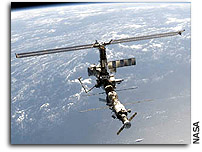ISS On-Orbit Status 24 Jul 2002
 All ISS systems continue to function nominally, except as noted previously or below.
All ISS systems continue to function nominally, except as noted previously or below.
Before breakfast, all crewmembers underwent the periodic Russian medical test PZE MO-9 (biochemical urinalysis). [MO-9 is performed with a sophisticated in-vitro diagnostic apparatus called ‘Urilux’ (developed by Boehringer/Mannheim in Germany for the Mir program), using a urinary dipstick to
measure specific gravity, nitrates, protein, glucose, ketones, urobilinogen,
bilirubin, and red and white blood cell counts. If not used for more
than seven days, the device is first calibrated with prepared calibration strips and then receives the measuring strips with the subject’s urine samples
for automatic (photometric) analysis. LEDs (light emitting diodes) in
dicate immediately if the data are within (green) or outside (red) the physiological norm, and they are also printed on a tape for report to MCC-M. &nbs
p;If the unit should fail, test parameters can also be visually evaluated with a color-coded scale.]
FE-2 Sergei Treschev reconfigured the ventilation system in the ISS RS
(Russian segment) back to nominal. Later, the new setup of air duct routings between the various modules was video recorded with the DVCAM digital
camera (which first had its battery recharged by Sergei) for ground inspection.
CDR Valery Korzun meanwhile performed a routine functional test of the IDZ-
2 A-4 smoke detector, a subunit of the FGB fire detection and fire suppression system (SPOPT). He then tagged up with a ground specialist via S-band.
FE-1 Peggy Whitson continued her work with the SUBSA (solidification using
a baffle in sealed ampoules) experiment, removing specimen ampoules and transferring recorded data to a microdisk. She then removed the videotape
from the camera used for recording the operation, and monitored the power-down of the MSG (microgravity science glovebox).
Treschev recorded acoustic noise levels on the Russian laptop #3 with the SM internal thermal loop (KOB) running, part of a systematic assessment of SM
noise sources. Later in the day he transferred the RS acoustic data o the U.S. MEC (medical equipment computer) for subsequent downlink.
Sergei also completed a periodic test of the Vozdukh emergency vacuum valve
and its redundant unit.
Both cosmonauts conducted two more sessions with the Russian/Japanese HDTV
(high-definition television) experiment of crew facial imaging for subsequent medical evaluation.
Peggy Whitson completed sample collection with the SSK (surface sample kit)
and colony growth for analysis, followed by collecting samples with the MAS
(microbial air sampler).
The CDRA (carbon dioxide removal assembly) in the Lab is still not working.
The ground transitioned it to STOP while the crew slept and awaits additional meetings to review the data from yesterday and to formulate a troubleshooting strategy.
In anticipation of the crew needing more potable water, MCC-H has added a CWC (collapsible water container) fill from the Lab condensate tank to the "job jar" task list starting today. Final disposition of a leaky CWC (#5087) is still pending, but the ground anticipates transferring the
water from that bag to a Russian EDV (water container).
The PuFF (pulmonary function in flight) team sent ‘lung-felt" thanks to the crew for another terrific monthly session. Peggy’s session was received on Ku-band, and everything looked great. POC (Payload Operations Center) is looking forward to the next monthly session in mid-August, which will also serve as the pre-EVA session for the two Orlan-EVAs scheduled mid- to late-month.
The crew participated in two PAO events today. The first was with Marshall Space Flight Center (MSFC) in Huntsville to announce a spectacular ISS
sighting opportunity during an overflight over Huntsville, Alabama, on 7/26
. The event on 7/26 is hosted by the National Space Science and Technology Center (NSSTC) with a "Space Station Block Party" (from 9:00
– 10:30 pm EDT) for families, students, and community leaders. The second was an audio/video Q&A interview with the Orange County Register (science program) in California via S- and Ku-band.
With the current high solar beta angle (today: 68.8 deg and still increasin
g), worldwide visibility of the ISS will be spectacular in the next few days
, sometimes 3-4 times a night. Visibility dates, times and viewing ang
es worldwide can be found at http://www.hq.nasa.gov/osf/station/viewing/issvis.html
Another sunspot, # 39, is now emerging from the Sun’s eastern limb and has already produced a powerful X-4 class flare along with a sizeable coronal mass ejection (CME) yesterday (7/23) at 7:00 pm EDT. Most of the CME is directed away from Earth. However, enough of the expanding plasm
a cloud is headed our way to suggest another spectacular auroral photo-op for the crew late today. There is no concern for crew safety.









